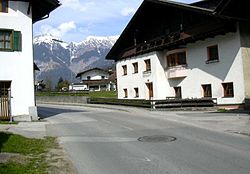Ampass
| Ampass | ||
|---|---|---|
 |
||
|
||
| Location within Austria | ||
| Coordinates: 47°16′00″N 11°26′00″E / 47.26667°N 11.43333°ECoordinates: 47°16′00″N 11°26′00″E / 47.26667°N 11.43333°E | ||
| Country | Austria | |
| State | Tyrol | |
| District | Innsbruck Land | |
| Government | ||
| • Mayor | Hubert Kirchmair | |
| Area | ||
| • Total | 7.9 km2 (3.1 sq mi) | |
| Elevation | 651 m (2,136 ft) | |
| Population (1 January 2016) | ||
| • Total | 1,810 | |
| • Density | 230/km2 (590/sq mi) | |
| Time zone | CET (UTC+1) | |
| • Summer (DST) | CEST (UTC+2) | |
| Postal code | 6070 | |
| Area code | 0512 | |
| Vehicle registration | IL | |
| Website | www.ampass.tirol.gv.at | |
Ampass is a municipality in the Innsbruck-Land District, Tyrol (Austria) situated at an altitude of 651 m, has an area of 7.9 km2 and 1793 inhabitants as January 2015.
Ampass is located on a terrace on the southern side of the Inn Valley, on an old salt road, from Hall in Tirol to Matrei am Brenner, currently Landesstraße L 38 (Ellbögener Straße). Ampass is connected directly to Innsbruck, which is 8 km far, with the road L 283 (Ampasser Straße). On the outskirts of the village is located the Taxerhof Lake, surrounded by a reed and a wet area, suitable to host herons and wagtails.
Ampass is likely to be inhabited in the fifteenth century BC as a result of a funerary urn, found on the hill, dating back to that period. A greater number of finds, such as arrowheads, bronze pins and beads, which have been found, dating back to the Hallstatt culture or to La Tène Culture. The Romans built a military road, which connected Hall in Tirol with Matrei am Brenner through Igls, Sistrans, Lans and Ampass. The only remaining evidence of the Roman period is a granite milestone 1.9 m high that is still in its original place, this was taken as a reference, in 1254, to delimit the boundary between the parishes of Wilten and Ampass. Ampass suffered in the seventh century, as the entire Tyrol, the invasion of Bavarii of which skeletal traces remain. In 1056 the Emperor Henry IV, Holy Roman Emperor, who succeeded at the age of six years to the death of his father Henry III, built a chapel, opened by the Bishop of Brixen Altwin and later elevated to "Royal Chapel".
...
Wikipedia



